|
|
 |  |  |
 |
В категории материалов: 153
Показано материалов: 31-40 |
Страницы: « 1 2 3 4 5 6 ... 15 16 » |
Сортировать по:
Дате ·
Названию ·
Рейтингу ·
Комментариям ·
Просмотрам
 East Asia was probably the center of origin Pantherinae. The oldest
tiger fossils indicate that about two million years ago tigers were
quite widespread in this region. However, the glacial and interglacial
climatic variations and other geological events caused repeated changes
in the geographic area. According to current information, the common
ancestor of modern tiger is out of time parameters 157-72.000 years ago.
This is much later than expected at the leopard, which is believed to
be originated in Africa 825-470.000 years ago and arrived in Asia
300-170.000 years ago. Ngadon tiger was the largest subspecies of
Panthera tigris. The body weight of this predator reached 400 kg, and
height at the withers - 120 cm. Nobody could argue with such a giant,
except perhaps awful American lion ( Panthera (Leo) atrox),
which was even greater. According to the assumptions of the last of
genetic research, the tigers have almost entirely disappeared at the end
of the Pleistocene era, maybe around 10.000-12.000 years ago. The small
remaining part of population survived, probably in the territory of
modern China. From this region the tigers again began to spread by
migrating along the river following their prey closely - mainly deer and
wild boars. Although the all continental tigers are closely related and
can be considered as regional populations, rather than separate
subspecies, they have developed definite physical and morphological
properties to adapt to environmental conditions.
The original image size (300 dpi:) A-4+ (A-3) - 300$ A-5 - 150$ A-6 - 100$
Bestiary |
Просмотров: 8478 |
Author: roman uchytel |
Добавил: rom-diz |
Дата: 11.01.2012
|
|
Bestiary |
Просмотров: 1696 |
Author: roman uchytel |
Добавил: rom-diz |
Дата: 11.01.2012
|
|
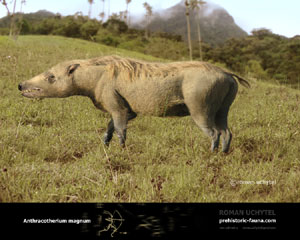 The original image size ( 300 dpi:) A-4+ (A-3) - 300$ A-5 - 150$ A-6 - 100$
Bestiary |
Просмотров: 1499 |
Author: roman uchytel |
Добавил: rom-diz |
Дата: 11.01.2012
|
|
Bestiary |
Просмотров: 4040 |
Author: roman uchytel |
Добавил: rom-diz |
Дата: 11.01.2012
|
|
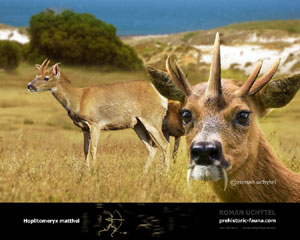 The original image size ( 300 dpi:) A-4+ (A-3) - 400$ A-5 - 200$ A-6 - 150$
Bestiary |
Просмотров: 1241 |
Author: roman uchytel |
Добавил: rom-diz |
Дата: 11.01.2012
|
|
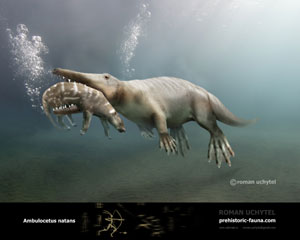 Ambulotsetus - genus of extinct cetaceans. One species is known -
Ambulocetus natans. He lived in the Eocene, in present-day Pakistan. Its
length was about 3 m and weighed about 300 kg. Externally they
resembled remotely a cross between a crocodile and a dolphin, with a
powerful tail and webbed feet adapted for movement in the water.
Probably, like modern crocodiles, they had waiting for a prey at the
bottom of the lake, jumped on it and dragged into the water. In the
water moved by means of movements back and tail in vertical direction.
On the land Ambulotsetus lumbered and never left far from the water. At
night this animal was on the shore, near the water. Ambulocetus,
with Pakicetus, belonged to Archaeocetes (the ancient whales) - a group
of animals of the order of cetaceans, from which later have occurred
modern whales.
The original image size ( 300 dpi:) A-4+ (A-3) - 300$ A-5 - 150$ A-6 - 100$
Bestiary |
Просмотров: 1351 |
Author: roman uchytel |
Добавил: rom-diz |
Дата: 11.01.2012
|
|
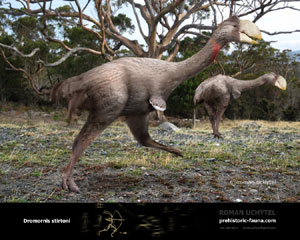 Dromornis stirtoni - an extinct family of Dromornithidae, one of the largest birds in the history of the Earth. These
birds belong to the order Anseriformes (Anseriformes) and were close
relatives of modern ducks and geese. At the height of Dromornis stirtoni
was about 3 feet and weighed about 500 kg. Lived in Australia, the
Middle Miocene, about 15 million years ago. They were probably
omnivorous. Previously it was thought that Dromornis stirtoni and
Epyornis maximus were the largest (heavy) birds in the history of the
fauna. However, recently paleontologists have found a skull of a
previously unknown species fororaka, who was given the name ( Kelenken guillermoi).
The original image size ( 300 dpi:) A-4+ (A-3) - 350$ A-5 - 200$ A-6 - 130$
Bestiary |
Просмотров: 1150 |
Author: roman uchytel |
Добавил: rom-diz |
Дата: 11.01.2012
|
|
 Moa – the giant birds that lived in New Zealand and became extinct at the end of the XVIII century. There
are 15 known species, among which Dinornis robustus and Dinornis
novaezelandiae are the largest. These two species reached a height of
3,5 m and weighed about 250 kg. They did not have wings, and even the
rudiments. Moa ate leaves, shoots and fruits. It is assumed that moa was
destroyed by Maori aborigines, for whom these birds were easy prey. The original image size ( 300 dpi:) A-4+ (A-3) - 200$ A-5 - 130$ A-6 - 100$
Bestiary |
Просмотров: 1327 |
Author: roman uchytel |
Добавил: rom-diz |
Дата: 11.01.2012
|
|
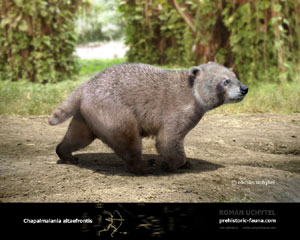 The
remains of Chapalmalania were found in South America, in areas
Chapalmal. Chapalmalania – a relative of raccoons (Procyonidae), who is
so larger than all other known members of this family, that he first
took for a bear. Sediments and chapalmalaliyas fauna show that the
Pliocene there was a plain or pampas with rich grasslands, some woody
vegetation and numerous streams. Rainfall was probably significant, but
the climate was at least as warm as present-day climate of this region;
it probably hasn’t had an impact of an approaching ice age. The
remains of Chapalmalania were found in South America, in areas
Chapalmal. Chapalmalania – a relative of raccoons (Procyonidae), who is
so larger than all other known members of this family, that he first
took for a bear. Sediments and chapalmalaliyas fauna show that the
Pliocene there was a plain or pampas with rich grasslands, some woody
vegetation and numerous streams. Rainfall was probably significant, but
the climate was at least as warm as present-day climate of this region;
it probably hasn’t had an impact of an approaching ice age.
The original image size ( 300 dpi:) A-4+ (A-3) - 500$ A-5 - 250$ A-6 - 150$
My Prints
Bestiary |
Просмотров: 1643 |
Author: roman uchytel |
Добавил: rom-diz |
Дата: 11.01.2012
|
|
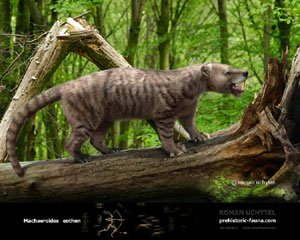 Machaeroides– saber-toothed
predators-creodontas not related to the cat family. Although they were
like a very big cats in their size, they hunted prey of their size,
because of specialization of saber-toothed in production of larger class
than insects, small lizards and birds. Their teeth are served for deep
penetration into the flesh. Machaeroides lived in the Early Eocene of North America in tropical rain forests. Machaeroides– saber-toothed
predators-creodontas not related to the cat family. Although they were
like a very big cats in their size, they hunted prey of their size,
because of specialization of saber-toothed in production of larger class
than insects, small lizards and birds. Their teeth are served for deep
penetration into the flesh. Machaeroides lived in the Early Eocene of North America in tropical rain forests. As a part of Machaeroidinae there are two genera – Machaeroides and Apataelurus. In turn, in the Machaeroideses genus there are two species: early Eocene small M.
simpsoni and latter (the end of Early Eocene) M. eothen. The second
types is larger and is known for finding a complete skull, femur,
humerus, bones of the forearm and hand.
The length of Machaeroides
from nose to tail base of over 60 cm at 30 cm in height. Probably, they
had wide half-plantigrade extremities. Finds massive limb bones, as a
small animal, assume strongly built and powerful predator.
The original image size ( 300 dpi:) A-4+ (A-3) - 300$ A-5 - 150$ A-6 - 100$
My Prints
Bestiary |
Просмотров: 1745 |
Author: roman uchytel |
Добавил: rom-diz |
Дата: 11.01.2012
|
|
|  |
 |  |  |
|
 |
| Кто здесь? |
 | Онлайн всего: 1 Гостей: 1 Пользователей: 0
|  |
 |
|
|

